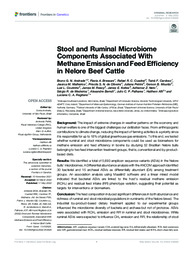Stool and ruminal microbiome components associated with methane emission and feed efficiency in Nelore beef cattle.
Stool and ruminal microbiome components associated with methane emission and feed efficiency in Nelore beef cattle.
Summary: Background: The impact of extreme changes in weather patterns on the economy and human welfare is one of the biggest challenges our civilization faces. From anthropogenic contributions to climate change, reducing the impact of farming activities is a priority since it is responsible for up to 18% of global greenhouse gas emissions. To this end, we tested whether ruminal and stool microbiome components could be used as biomarkers for methane emission and feed efficiency in bovine by studying 52 Brazilian Nelore bulls belonging to two feed intervention treatment groups, that is, conventional and by-product-based diets. Results: We identified a total of 5,693 amplicon sequence variants (ASVs) in the Nelore bulls? microbiomes. A Differential abundance analysis with the ANCOM approach identified 30 bacterial and 15 archaeal ASVs as differentially abundant (DA) among treatment groups. An association analysis using Maaslin2 software and a linear mixed model indicated that bacterial ASVs are linked to the host?s residual methane emission (RCH4) and residual feed intake (RFI) phenotype variation, suggesting their potential as targets for interventions or biomarkers. Conclusion: The feed composition induced significant differences in both abundance and richness of ruminal and stool microbial populations in ruminants of the Nelore breed. The industrial by-product-based dietary treatment applied to our experimental groups influenced the microbiome diversity of bacteria and archaea but not of protozoa. ASVs were associated with RCH4 emission and RFI in ruminal and stool microbiomes. While ruminal ASVs were expected to influence CH4 emission and RFI, the relationship of stool taxa, such as Alistipes and Rikenellaceae (gut group RC9), with these traits was not reported before and might be associated with host health due to their link to anti-inflammatory compounds. Overall, the ASVs associated here have the potential to be used as biomarkers for these complex phenotypes.
Publication year: 2022
Types of publication: Journal article
Observation
Some of Embrapa's publications are published as ePub files. To read them, use or download one of the following free software options to your computer or mobile device. Android: Google Play Books; IOS: iBooks; Windows and Linux: Calibre.
Access other publications
Access the Agricultural Research Database (BDPA) to consult Embrapa's full library collection and records.
Visit Embrapa Bookstore to purchase books and other publications sold by Embrapa.

